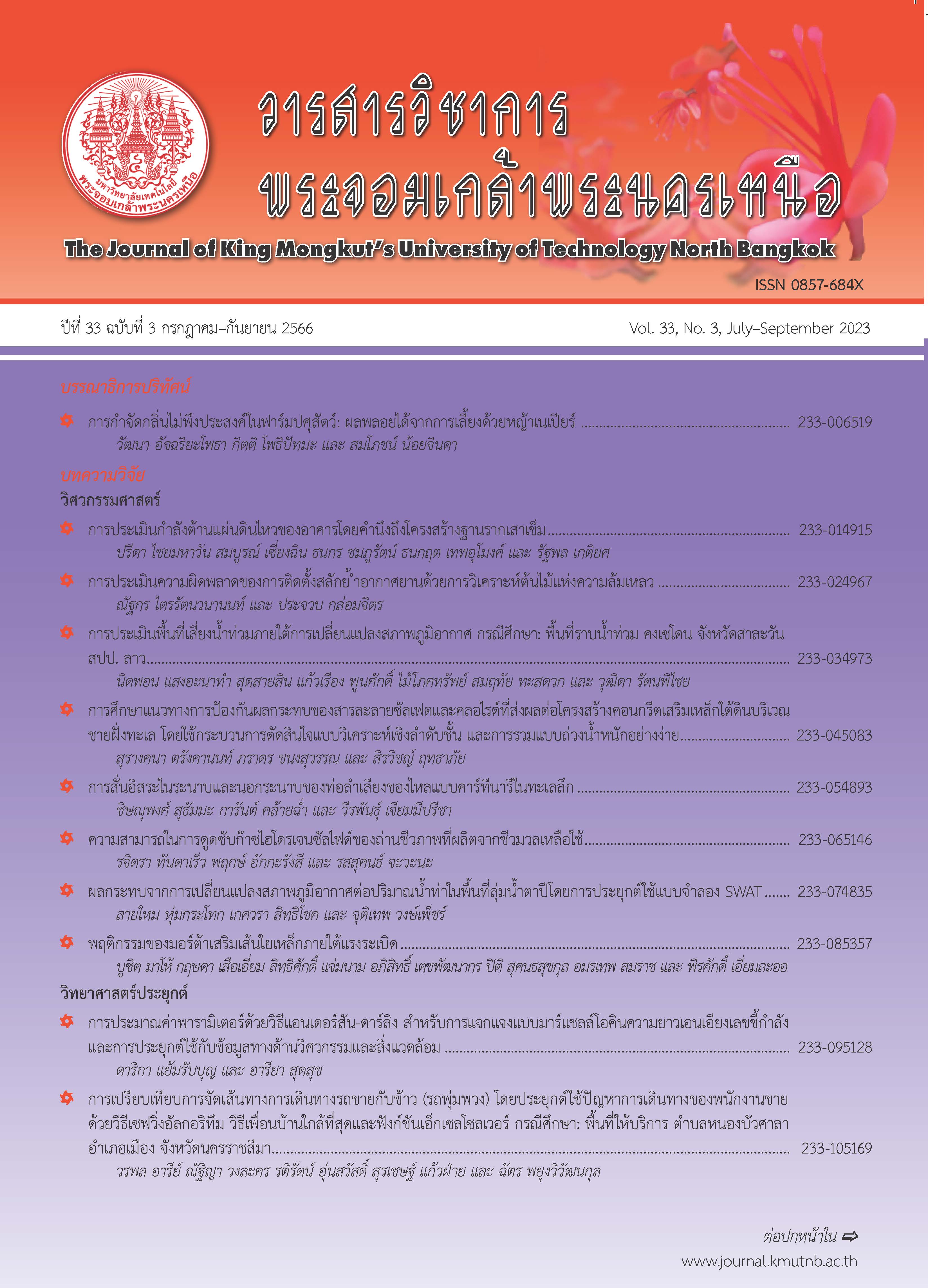การพัฒนารูปแบบสมรรถนะผู้บริหารด้านความปลอดภัยในการก่อสร้างอุตสาหกรรมระบบราง
Main Article Content
บทคัดย่อ
งานวิจัยครั้งนี้มีวัตถุประสงค์ 1) เพื่อศึกษาองค์ประกอบรูปแบบสมรรถนะผู้บริหารด้านความปลอดภัยในการก่อสร้างอุตสาหกรรมระบบราง 2) เพื่อพัฒนารูปแบบสมรรถนะผู้บริหารด้านความปลอดภัยในการก่อสร้างอุตสาหกรรมระบบราง และ 3) เพื่อจัดทำคู่มือการพัฒนาสมรรถนะผู้บริหารด้านความปลอดภัยในการก่อสร้างอุตสาหกรรมระบบราง งานวิจัยนี้เป็นแบบผสมผสานเชิงคุณภาพและเชิงปริมาณ โดยมีการสัมภาษณ์เชิงลึกกับกลุ่มผู้ทรงคุณวุฒิ จำนวน 5 ท่าน กลุ่มตัวอย่างในการตอบแบบสอบถามเพื่อการวิเคราะห์องค์ประกอบเชิงสำรวจ จำนวน 140 ท่าน และกลุ่มผู้ทรงคุณวุฒิในการประชุมสนทนากลุ่มประชาพิเคราะห์ จำนวน 13 ท่าน จากผลการศึกษาพบว่า องค์ประกอบหลักของการพัฒนารูปแบบสมรรถนะของผู้บริหารด้านความปลอดภัยในการก่อสร้างอุตสาหกรรมระบบรางประกอบด้วย 3 องค์ประกอบหลัก 12 องค์ประกอบย่อยคือ องค์ประกอบด้านความรู้ (Knowledge) มีค่าเฉลี่ยอยู่ในระดับมาก (X̅ = 3.92, S.D. = 0.617) โดยมี 5 องค์ประกอบย่อย คือ 1) ความรู้เกี่ยวกับการจัดการแผนงานด้านความปลอดภัยในองค์กร 2) ความรู้เกี่ยวกับการบริหารงานก่อสร้าง 3) ความรู้เกี่ยวกับกฎหมายความปลอดภัย อาชีวอนามัยและสิ่งแวดล้อมในงานก่อสร้าง 4) ความรู้เกี่ยวกับเทคโนโลยีด้านความปลอดภัยในการก่อสร้าง และ 5) ความรู้เกี่ยวกับการบริหารจัดการความเสี่ยงด้านความปลอดภัย 2) องค์ประกอบด้านทักษะ (Skills) มีค่าเฉลี่ยอยู่ในระดับมาก (X̅ = 3.91, S.D. = 0.628) โดยมี 4 องค์ประกอบย่อย คือ 1) ทักษะการคิดวิเคราะห์และการปรับปรุงงานอย่างต่อเนื่อง 2) ทักษะการจัดการองค์กร 3) ทักษะการบริหารการสื่อสารภายในและภายนอกองค์กร และ 4) ทักษะทางด้านเทคโนโลยีสารสนเทศด้านความปลอดภัย 3) องค์ประกอบด้านคุณลักษณะ (Attributes) มีค่าเฉลี่ยอยู่ในระดับมาก (X̅ = 4.36, S.D. = 0.617) โดยมี 3 องค์ประกอบย่อย คือ 1) การใฝ่เรียนรู้และความคิดริเริ่มสร้างสรรค์ 2) ความรับผิดชอบ และ 3) บุคลิกภาพและมนุษย์สัมพันธ์ จนสามารถสรุปเป็นคู่มือการพัฒนาสมรรถนะผู้บริหารด้านความปลอดภัยในการก่อสร้างอุตสาหกรรมระบบราง โดยได้รับความเห็นชอบจากผู้ทรงคุณวุฒิด้วยฉันทามติคิดเป็นร้อยละ 100 ซึ่งมีความเหมาะสม สอดคล้องกับเนื้อหาและสามารถนำไปใช้พัฒนาสมรรถนะของผู้บริหารด้านความปลอดภัยในการก่อสร้างอุตสาหกรรมระบบราง และสามารถประยุกต์ใช้กับอุตสาหกรรมก่อสร้างอื่นๆ ได้
Article Details

อนุญาตภายใต้เงื่อนไข Creative Commons Attribution-NonCommercial-NoDerivatives 4.0 International License.
บทความที่ลงตีพิมพ์เป็นข้อคิดเห็นของผู้เขียนเท่านั้น
ผู้เขียนจะต้องเป็นผู้รับผิดชอบต่อผลทางกฎหมายใดๆ ที่อาจเกิดขึ้นจากบทความนั้น
เอกสารอ้างอิง
K. Motana, “Thailand's transport infrastructure development strategy 2015-2022,” Journal of The National Defence College of Thailand, vol.58, no.1, pp. 94–99, 2016 (in Thai).
SHAWPAT. (2020). The Occupational Health and Safety Working Group [Online] (in Thai). Available: http://shawpat.or.th/index (in Thai).
MRTA. (2016). The Administration and Human Resource Development Strategy Plan. [Online] (in Thai). Available: https://mrta.co.th/media/ 550262.pdf
D. C. McClelland, “Testing for competence rather than for intelligence,” American Psychologist, vol. 28, no.1, pp. 1–14, 1973.
E. Worasakdapisarn, “Relationship between safety management factors and safety performance in building construction project,” M.Eng. thesis, Department of Construction and Infrastructure Management, Faculty of Engineering Suranaree University of Technology, 2014 (in Thai).
P. Ruengnak, “Construction safety management and accident prevention costs of Choke Praphan Construction Co., Ltd.,” MBA. thesis, Department of Accounting, Faculty of Business Administration Rajamangala University of Technology Thanyaburi, 2011 (in Thai).
M. Chumthong, “Safety management in work station,” B.Eng. Cooperative education, Department of Industrial Engineering, Faculty of Engineering Siam University, 2014 (in Thai).
J. M. Kiatmontri, “Safety in building construction: A case study of specially large buildings in Chulalongkorn University,” M.Arch. thesis, Department of Architecture, Faculty of Architecture Chulalongkorn University, 2013 (in Thai).
MOL. (2017, Sep). The ministerial regulation prescribing the standard for administration and management of occupational safety, health and environment for construction work, B.E. 2551. [Online] (in Thai). Available: http://mol. go.th/sites/default/files/laws/th/safety_construction_ 2551.pdf
B. Suwannung, “A study of risk factors affecting the construction projects of petrochemical industry: An owner perspective,” M.Eng. thesis, Department of Construction and Infrastructure Management Engineering, Faculty of Engineering Burapha University, 2016 (in Thai).
S. Monkaew and T. Nawalerspunya, “Construction safety system for working at height,” Research Funding, Faculty of Engineering Rajamangala University of Technology Phra Nakhon, 2015 (in Thai).
W. Schramm and D. F. Roberts, The Process and Effects of Mass Communication, Urbana, Chicago: University of Illinois Press, 1971.
A. J. Zaremba, Organizational Communication: Foundations for Business & Management, Mason, Ohio: Thomson South-Western, 2003.
C. Gerdsuk and K. Inwang, “Creative leadership model of construction industry project management: Affiants team group,” Ph.D. in Social Sciences Journal, vol. 9, no. 1, pp. 193–205, 2019 (in Thai).
The handbook to guide on the essential competency for civil servant: The handbook to guide on the essential competency for administration, Prachoomchang company limited, Bangkok (in Thai).

